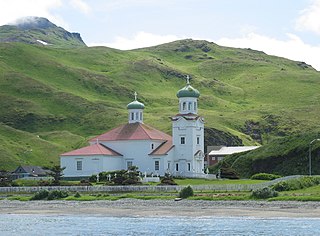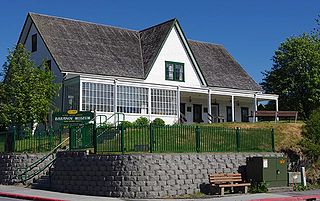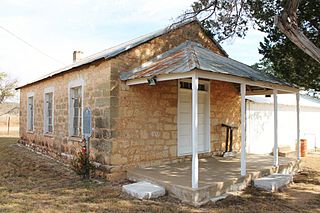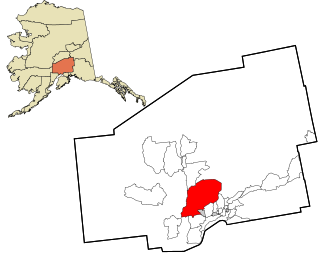
Cape Krusenstern National Monument and the colocated Cape Krusenstern Archeological District is a U.S. National Monument and a National Historic Landmark centered on Cape Krusenstern in northwestern Alaska. The national monument is one of fifteen new National Park Service units designated by the Alaska National Interest Lands Conservation Act (ANILCA) of 1980. It was initially declared a national monument under the authority of the Antiquities Act by President Jimmy Carter on December 1, 1978.

St. Michael's Cathedral is a cathedral of the Orthodox Church in America Diocese of Alaska, at Lincoln and Matsoutoff Streets in Sitka, Alaska. The earliest Orthodox cathedral in the New World, it was built in the nineteenth century, when Alaska was under the control of Russia. After 1872, the cathedral came under the control of the Diocese of Alaska. It has been a National Historic Landmark since 1962, notable as an important legacy of Russian influence in North America and Southeast Alaska in particular.

The Church of the Holy Ascension, also known as the Holy Ascension Orthodox Church, is a prominent landmark in Unalaska, the major community of the western Aleutian Islands in southwestern Alaska. The current church was built in 1894, probably on the site of an 1826 church, and likely using timbers and other elements from the older church. It is one of the oldest churches in Alaska, and is significant as the site from which missionaries brought their religion to the local Aleut people. This evangelization effort was so successful that today's Aleut population is still strongly Orthodox. The church was declared a National Historic Landmark for its architecture, and for its role in the history and culture of Alaska. It is the second cathedral church of the Orthodox Church in America Diocese of Alaska, after St. Michael's Cathedral in Sitka.

The Baranov Museum is a history museum at 101 East Marine Way in Kodiak, Alaska. It is located in a National Historic Landmark building known as the Russian-American Magazin [sic] and the Erskine House, which also houses the office of the Kodiak Historical Society. Built c. 1810, the building is the oldest of four surviving building constructed by the Russians when Alaska was a Russian territory. The museum's collections and exhibits are focused on the history of the Kodiak Archipelago and the Aleutian Islands, with particular focus on the Russian and early American periods. The museum's current director is Sarah Harrington.

The Anchorage Memorial Park, also known as Anchorage Cemetery, is a 22-acre (89,000 m2) cemetery located in Anchorage, Alaska, USA. Covering nine city blocks, the cemetery separates the city's downtown and Fairview neighborhoods.

This is a list of the National Register of Historic Places listings in Yukon–Koyukuk Census Area, Alaska.

This is a list of the National Register of Historic Places listings in Skagway, Alaska.

The Redoubt St. Archangel Michael Site, also known as the Old Sitka Site and now in Old Sitka State Historical Park, is a National Historic Landmark near Sitka, Alaska. Now of archaeological interest, the site, about 7 miles (11 km) north of Sitka at the end of Halibut Point Road, was the site of the early Russian-American Company settlement known as Redoubt St. Archangel Michael. It was the first non-Native settlement on Baranof Island. It was declared a National Historic Landmark in 1962, and was made a state park in 1966.

Willow City School is at 2501 Ranch to Market Road 1323 in Gillespie County, in the U.S. state of Texas. It was consolidated with Fredericksburg Independent School District in 1961. The building is now used as a community center. It was added to the National Register of Historic Places listings in Gillespie County, Texas on May 6, 2005.

Crabapple School is located at 14671 Lower Crabapple Road in Gillespie County, in the U.S. state of Texas. It was consolidated with Fredericksburg Independent School District in 1957. The building is now used as a community center. It was added to the National Register of Historic Places listings in Gillespie County, Texas on May 6, 2005.

The Central House, also known as Erickson & Stade's, at Mile 128 on the Steese Highway in Central, Alaska, was a log structure built in 1926 by Riley Erickson and John Stade, replacing an 1894 log and sod structure that was burned in a 1925 fire. It served as a roadhouse restaurant and hotel, and was listed on the National Register of Historic Places in 1978.

The Clover Pass School is a historic school building in Ketchikan Gateway Borough, Alaska. It is located 16 miles (26 km) north of the city of Ketchikan, at the junction of Potter and Knudson Cove Roads. The small one-room wood-frame structure was built in 1947, and was used as a school until 1961. It thereafter was used as a local community center, and is now owned by Historic Ketchikan.

The MacKinnon Apartments are a historic apartment building at 236 Third Street in Juneau, Alaska. It is a three-story wood frame structure, finished in stucco, with corner quoining and a dentillated cornice. When originally built in 1925, it was 80 feet (24 m) long and housed six single-bedroom and 12 studio apartments. In 1959 another 20 feet (6.1 m) were added, housing another five studio units. The building is a representative of Juneau's boom years in the 1920s, when the local gold rush peaked.

The Mayflower School, now known as Juneau Montessori School, is a historic school building at St. Ann's and Savikko Streets in the Douglas part of Juneau, Alaska. It is significant as the only surviving historic Native school building in the Juneau-Douglas area. It is also the only Colonial Revival style BIA school in Alaska. Its nomination to the National Register of Historic Places in 1988 asserts the school was "a source of great pride to the Douglas Native community" and that it "represents a significant tie with the past for many Douglas Native people."

The Mike Alex Cabin is a historic log cabin in Eklutna, Alaska. Located across from Eklutna's Russian Orthodox churches in the center of the community, it was built in 1925 for Mike Alex, the last traditional clan chieftain of the Athabaskan people in Eklutna. It consists of three sides of an originally square log structure, to which a log addition was made in the 1930s, removing one of the original four walls. The building was around that time also topped by a new gable roof. It is, along with the older church, a reminder of the people's history.

The Copper River and Northwestern Railway Bunkhouse and Messhouse are historic railroad worker facilities on Third Street in Chitina, Alaska. The messhouse is a single-story wood frame structure with a hip roof, measuring 26 by 30 feet. It has a porch on the east side, and a timber-braced entrance on the west side leading to a root cellar under the building. The bunkhouse is also a single-story structure, measuring 43 by 25 feet. It has an enclosed porch on its southern facade, and is divide internally into two large chambers. These facilities were built in 1910 by the Copper River and Northwestern Railway to house its work crews, a service they performed until the railroad shut down in 1938. They are the only surviving elements of what was once a larger CR&NW presence in the community. The buildings are now hosting the Chitina House bed and breakfast.

The Knik Site, also known as the Old Knik Townsite, is the location in Matanuska-Susitna Borough, Alaska that was once home to the largest settlement on Cook Inlet. The only surviving remnants of the community are a former log roadhouse, now a museum operated by the Wasilla-Knik Historical Society, and a log cabin. The Knik area had long been a meeting point of Native Alaskans, and in 1898 it became the principal community on Cook Inlet from which goods were shipped into the interior. In 1916 the Alaska Railroad reached the site of present-day Anchorage, bypassing Knik and leading to Anchorage's growth. When the railroad reached Wasilla, Knik lost all importance as a transshipment point, and its buildings were either abandoned or moved to one of the other communities. Knik is located about 13 miles (21 km) southwest of Wasilla.

The Sutton Community Hall is a historic municipal building in Sutton, Alaska. It is located on the west side of Jonesville Road, about 0.25 miles (0.40 km) north of its junction with the Glenn Highway. It is a single-story wood frame structure, measuring 40 by 70 feet, with a shallow-pitch gabled sheet metal roof. The building has entrances on the north, south and east sides, the east-facing one sheltered by a hood with diagonal bracing. The exterior has several types of cladding, including asphalt shingles and board-and-batten siding. The building was built in 1927 to serve as a bunkhouse for workers building the Eklutna Power Plant, and was moved to the present location in 1950 to serve the unincorporated community of Sutton as a meeting space. The hall served the community as its principal civic and social meeting space for forty years.

The Palmer Depot is a historic train station at South Valley Way and Evergreen Avenue in Palmer, Alaska. It is a large three-section single story frame structure, built in 1935 to provide transportation services to the newly established Matanuska Valley Colony. The main section is the former warehouse, which is 94 feet (29 m) long. The next section, with a lower profile than the warehouse, housed baggage facilities, a passenger waiting area, and living quarters for the station agent. The third section, the smallest of the three, houses the former ticketing office. The building now houses a community center.

The St. Nicholas Chapel is a historic Russian Orthodox church in the Alaska Native village of Nondalton, Alaska, United States. Now it is under Diocese of Alaska of the Orthodox Church in America






















